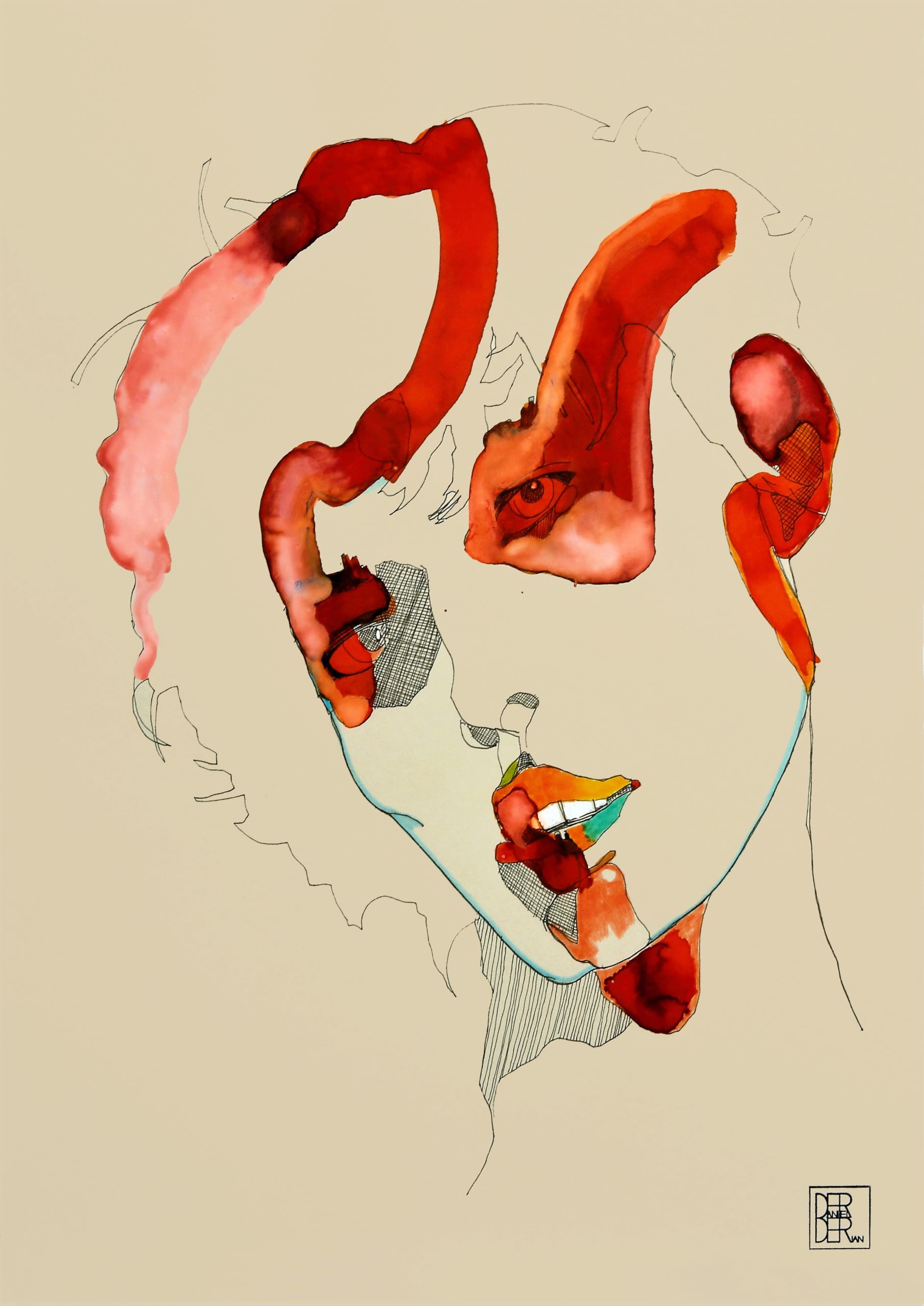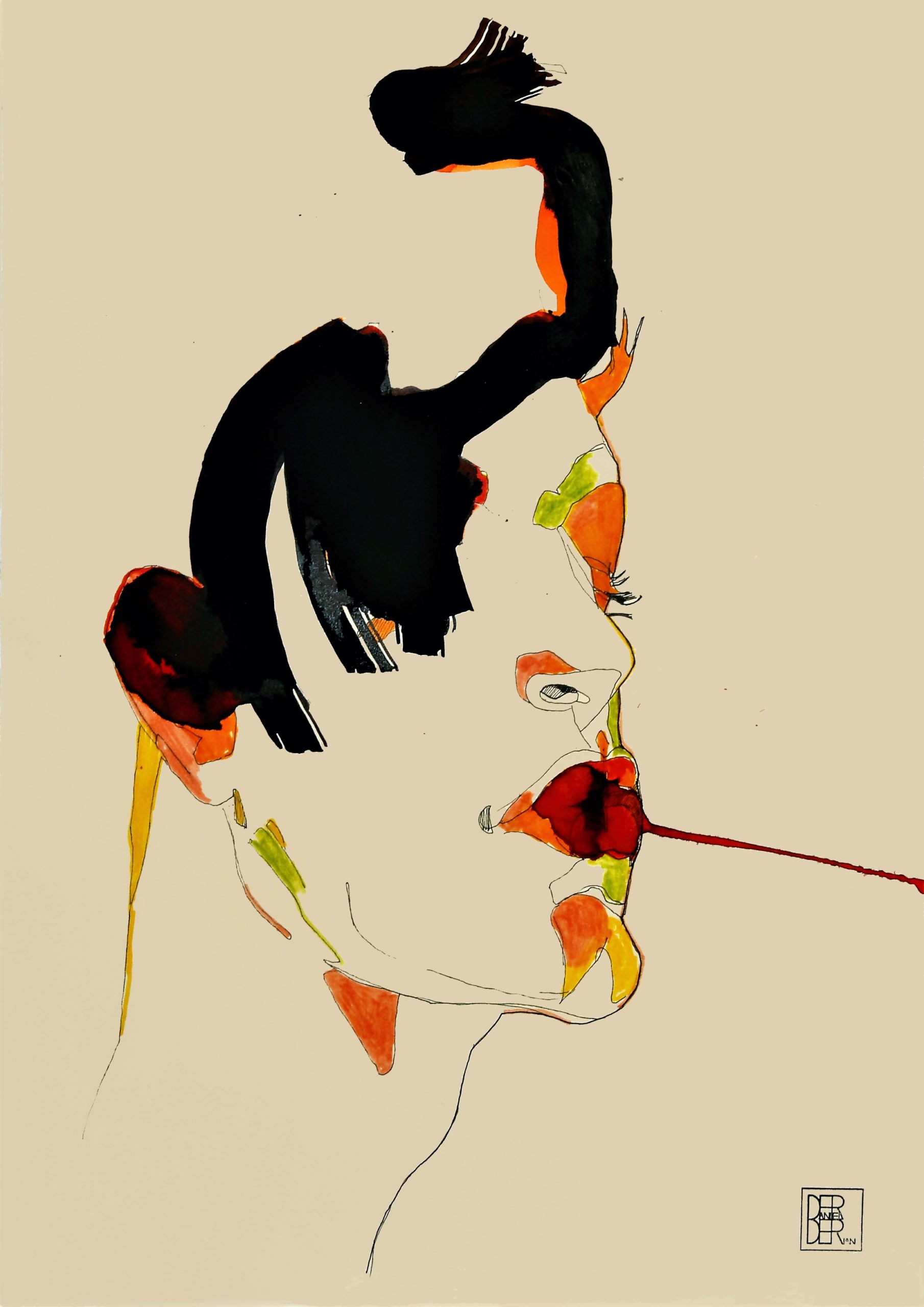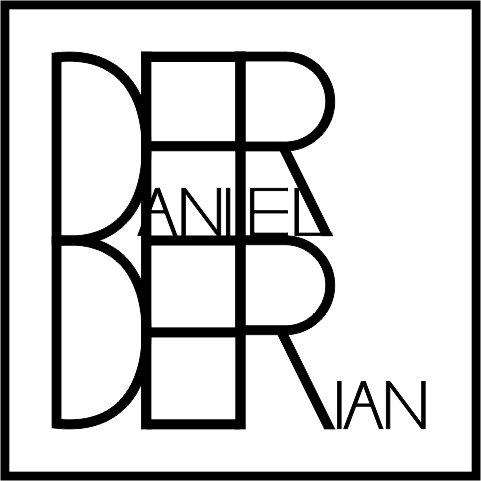Daniel Derderian Interview with Giorgia Basili
- 7 min read
Pride By Your Side: Interview with Daniel Derderian

Your figures seem to melt, perhaps because of the impact with reality, but they remain solid in their main contours, on the one hand, expressing interchangeable profiles and on the other hand, retaining in some way the essence of their being… would you like to tell us about the feeling that your figures seem to imprint on the observer? What do you want to communicate and what escapes your intentionality?
Emotionally, I have probably few barriers, socially, I have built a very solid shell, which is risky to wear. I work intuitively on these layers, these filters that are too present or absent.
If I am more graphic in my work and there are very clear or even exaggerated demarcations, I work more on the appearance, on markers that are easily distinguishable for others. I explore the limits we impose on ourselves, in order to be able to live with them, and to leave freedom to the others. It is often a softer, more positive, more accessible universe.
If I let go and the contours become more blurred, more wild, I explore more the impulsivity, the violence, the rage and the anger that live inside me. All this, nourished by an existential anguish, is covered by few filters. Maybe somehow, because of my origins, being third generation after the genocide, I feel guilty about my existence.
Literally, some lines are assertive, insistent, while other parts are lost in vagueness, in nothingness. We have fuzzy, fragile, introspective areas and more precise, strong, extroverted areas. The dialogue makes the beauty and the mystery of a human-being, its paradox. My figures are appearances, packages with cracks. The lines, the demarcations can guide, reassure and allow access to the artwork. The blurs and gaps can suggest an opening and create an availability to associate and relive a lost, hidden, forgotten feeling and move a moment. I find that we often see many different things in the same work.

The dancing profiles of your figures, where colour marks the outline and leaves the flesh transparent to the empty field of the background, probably have something to do with your connection to dance. However, you often choose to portray only the faces, in profile or three-quarter perspective, and not the entire bodies of the subjects you portray, why?
Why do you often portray the flesh as intangible?
As a confused and precocious child, I placed myself in front of a mirror and with classical dance I structured my body in a very strict, very demanding mould. The French school of classical dance was established by Louis XIV. I built an appearance that was strongly anchored in a heritage.
My adult life as a ‘handsome guy’ and my work were very much about appearance, very little about who I was as a human being with feelings, questions and a lot of uncertainties. I was carefree to build an inner life and to realize my quest for love.
Nowadays, if I draw or paint bodies, they are still quite strong in that classical dancer’s mould. They are static with very strict poses, often they have no footing.
When I draw or paint heads, I believe that it is the adult in me who is rationalizing what a body could feel. Is it the awakening of a conscience? Is it a twig of spirituality that comes with age? A desire to live in the moment?
The most intensely worked areas are often the senses: eyes, ears, mouth, nose. The eyes, as windows to the soul, often overflow. They are hollow, sometimes pierced, when I regress. The skin is in itself the limit of appearance and the cover of the inner being. It is also the real limit for the other. I often decorate these surfaces to cover its vulnerability, its nakedness, its transparency.

Which readings, visual, sound or cinematographic works have influenced or are influencing your work?
From my youngest adolescence in search of answers to the great existential questions I read Sartre‘s work. The dilemma in ‘Letters to a Young Poet’ by Reiner Maria Rilke forged my passions and motivated me to build a career in art through classical dance, performance, theatre, dance teaching and finally plastic art, in the continuity of a very passionate need to express myself, to leave traces.
My work is more about the individual and his identity than about great social causes. Is it a search to find me a place in something bigger? I explore the layers between the most deeply impulsive intimacy and the fully constructed public image; between the desire to be like others or to be completely different.
I went through a lot of therapies. Psychology prompted me to read some of Freud‘s works. During my training as an actor, I found in Tennessee Williams‘ work this world of impulses and frustrations, of traumas that condition the fate of people.
More recently, as a solitary visual artist, I have come to appreciate the desolate and very realistic universe of Houellebecq.
I am inspired a lot by images of models that have been captured by photographers. I’m looking for particularities that catch my eye. I especially like androgynous characters who pose in sensuality, seduction, desire. Shortly before the lockdown I discovered a book of fashion photos by Rick Owen that inspired me a series of about fifty paintings. On a return from a holiday in Palermo I made drawings of boys at the beach, with powerful and defiant looks as can be seen in films by Fellini and Pasolini. In The Damned of Visconti there is a whole series of characters that inspired me. Sylvana Mangano is my ideal female beauty archetype. I love Isabelle Huppert for her little grain of madness.
As a classical dancer I have worked with many styles of music, sometimes very detailed, analyzed to the point of every measurement. In classical music my favorites are probably Beethoven for strength and torment, Chopin for his dreamy melancholy.
In the eighties I was on one side, particularly a fan of Laurie Anderson for the minimalism, the experimental, clinical and cold sound and at the opposite by Nina Hagen for her exuberance and punk provocation. Obviously there are also those great singers like Piaf, like Barbara with their poetry and the particular narrative and Amy Winehouse with her raw cry of the soul.
In painting I am probably influenced by Egon Schiele for the shape and tension of the bodies, by Francis Bacon for the twisting and distortion of reality, by Soutine for the carnal colors and by Modigliani for the absent and empty look of his characters. I love Rembrandt’s clair-obscure and the mysticism of the Flemish Primitives.

How are you experiencing this difficult time of the pandemic? Is your work moving forward or do you feel held back and disheartened (due to lack of contacts/resources)?
I experienced the beginning of this period as very alienating and as a collective fear was growing and societal life stopped, the usual references changed. As I worked little as dance teacher, time somehow stopped, or at least expanded. Protective intimacy imposed itself. I was in my own artistic confinement. In my bubble of solitude I composed a lot of portraits and in my fantasy they became characters who accompanied me during this period of very fruitful production. For the first confinement in Paris I developed many paintings, family portraits, inspired by the work of the couturier Rick Owen whom I named The family of Rick. For the second lockdown in Belgium, in Ghent I used my Flemish partner as a model and I named this series Claire.
I also took advantage of the lockdown to develop my communication through social networks. In October 2020 I participated in the Open Doors of the artists’ workshops of Montreuil.
Are there some LGBT+ artists you find inspirational considering your style and poetic?
From an early age, being gay seemed obvious to me. In the 80s, to be able to live my identity freely in a reassuring setting, I wanted to be a classical dancer. I found my passion and my job there. I worked with Roland Petit at the Ballet National de Marseille and then at the Het Nationaal Ballet in Amsterdam with the choreographer Hans Van Manen.
In creations of Roland Petit we wore costumes by Yves Saint Laurent, we danced in sets by David Hockney and Keith Haring. With Hans Van Manen, desire and sexual freedom were omnipresent through his artistic work. Hans was also a wonderful photographer. I was his model for a photograph that was on the cover of a German gay magazine. These companies were bathed at that time in an atmosphere of lightness, of carelessness rather frivolous and erotic. The dancer had a very sensual relationship to the body. Dancing for those choreographers was liberating. I felt like I was a subject of desire, of living another form of sexuality sublimated by art. It was very exhilarating. These experiences have forged my aesthetics and tastes and influenced my work as a visual artist. I play with postures, poses, looks in my drawings and paintings, similar to when I was young and on stage.
If you had to advise a young boy or a young girl who approaches the LGBT+ world how would you help him/her to face his / her choices?
Every story is different and that’s fine. We are all searching for love. And there is no formula or speed with which one forges one’s identity. In case you do not immediately find the security you need in your real family to develop, and be as fulfilled and happy as you deserve, you can build a second family. Choose friends with whom you feel confident and with whom you share respect, encouragement and solidarity.
My participation in Sit-ins with Act Up, in Gay Pride parades in the streets of Paris, helped to confirm and defend myself and to consolidate my pride. It was reassuring to be part of something larger than my own person and it gave me a sense of usefulness in building continuity for future generations. Because nothing is definitively taken for granted if we see recently what is happening in Hungary with Orban. Perhaps the best is yet to be accomplished? The evidence of acceptance? The evidence and pride of a culture among the diversity of many others?
© All rights reserved FMB Art Gallery / FMB Globo Arte srls
